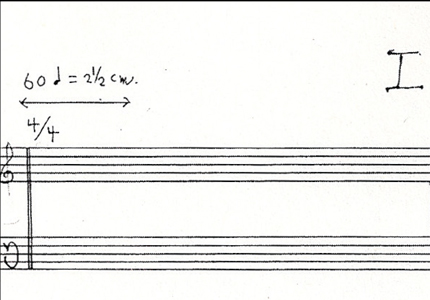A Prolonged Silence: John Cage and Still After
 September 5, 2012 marks the 100th birthday of American composer John Cage, most often known for the silently performed 4’33’’. Though Cage’s silence as a composition has been deeply considered on Yale University Press’s list with Kyle Gann’s Icons of America book, No Such Thing as Silence, the reach of his influence and experimentation extends into other media, as well.
September 5, 2012 marks the 100th birthday of American composer John Cage, most often known for the silently performed 4’33’’. Though Cage’s silence as a composition has been deeply considered on Yale University Press’s list with Kyle Gann’s Icons of America book, No Such Thing as Silence, the reach of his influence and experimentation extends into other media, as well.
 This month, we will publish Silence, by Toby Kamps and Steve Seid, a radical book about the idea of silence in art, distributed for the Menil Collection and the University of California Berkeley Art Museum and Pacific Film Archive. These institutions have collaborated on a fascinating and wide-ranging multimedia exhibition, which is currently on view at the Menil and will move to Berkeley in January. If you’re able to visit the exhibition, we highly recommend it. If you’re unable, the book offers nearly 100 images – film stills, archival photographs, and artworks – that suggest silence in varied, often unexpected or indirect, ways. The book also contains deeply insightful essays; here is a teaser sneak-preview of the essay ”A Prolonged Silence: John Cage and Still After” by art historian Jenni Sorkin.
This month, we will publish Silence, by Toby Kamps and Steve Seid, a radical book about the idea of silence in art, distributed for the Menil Collection and the University of California Berkeley Art Museum and Pacific Film Archive. These institutions have collaborated on a fascinating and wide-ranging multimedia exhibition, which is currently on view at the Menil and will move to Berkeley in January. If you’re able to visit the exhibition, we highly recommend it. If you’re unable, the book offers nearly 100 images – film stills, archival photographs, and artworks – that suggest silence in varied, often unexpected or indirect, ways. The book also contains deeply insightful essays; here is a teaser sneak-preview of the essay ”A Prolonged Silence: John Cage and Still After” by art historian Jenni Sorkin.
Jenni Sorkin—
While John Cage always made the claim that it was Robert Rauschenberg’s White Paintings that prompted 4’33’’, also known as “the silent piece,” there were other influences in the geneaology of its creation. The work was composed mostly during Cage’s summer of 1952 at Black Mountain College, North Carolina, where he had been teaching alongside painter Franz Kline and poet Charles Olson.
First performed August 29, 1952, in Woodstock, New York, the silent piece is bracketed by three crucial moments, all occurring within a span of seven months: in June, Cage’s famed event known as Theater Piece #1 was performed at Black Mountain; in October, Black Mountain College held an international pottery seminar, where Buddhist thought was disseminated through workshops and lectures; and in December, Harold Rosenberg’s seminal article “American Action Painters” was published in ARTnews. These occurrences were not coincidental: all can be traced through BlackMountain. With its roster of radical teachers and thinkers, such as Josef Albers, M.C. Richards, and Olson, the college became both conduit and catalyst for an emergent strain of avant-garde artistic production, including its Light Sound Movement Workshop that was active from 1949 to 1951.

Flyer for Black Mountain College Pottery Seminar, 1952, Black Mountain College Archives, North Carolina State Archives, Raleigh
Credited as the first-ever Happening in postwar art, Theater Piece #1 also functioned as a reinvention of a late-nineteenth-century idea that lingered in avant-garde art and music: the Wagnerian Gesamtkunstwerk, a “total work of art” in which the melding of a plethora of art forms—dance, poetry, oral recitation, music, painting—serves as a conjoining process that restores freedom through unity. Richard Wagner saw the solitary art form as profoundly limited by its lack of integration. Or, as the art historian Juliet Koss describes it, “in joining the Gesamtkunstwerk, each art form grew stronger in the struggle to define itself against the others and became more independent in the process. … The interrelation of the arts provided the necessary conditions for ensuring the autonomy of each.”
But the Happening also proved overwhelming to its audience, impeding the possibility of silent reflection. In this way, 4’33’’ is its exact opposite, a composition during which, for the premiere, the pianist David Tudor closed the keyboard cover at the beginning, and then raised and reclosed it between movements, all while stationed silently at the keyboard for four minutes and thirty-three seconds.
The work exemplifies Cage’s radical, and constantly evolving, aesthetic, effectively demonstrating that first, the artist has only to produce the conditions for artistic production to occur; second, all sound has the potential to be music; and finally, there is no actual silence, anywhere, at any time, since the sounds emanating from the concert audience become the performance itself. A tantalizing impossibility is offered: no fidelity to the score could ever exist, since the privileging of the audience displaces the centrality of the performer. Or, as Seth Kim-Cohen observes, “[Cage] sought to overturn the presumptions, habits and hierarchies that had set [classical] music’s agenda for three hundred years.”
Jenni Sorkin is assistant professor of contemporary art and critical studies at the University of Houston. Her essays have appeared in a number of publications and she is the recipient of the 2004 Art Journal award. Sorkin is currently working on a book examining the legacy of Black Mountain College, craft pedagogy, and the history of ceramics from 1952-72.
Excerpted from Silence, by Toby Kamps and Steve Seid. Copyright © 2012 by Menil Foundation, Inc., Houston, and UC Berkeley Art Museum and Pacific Film Archive. All rights reserved.




